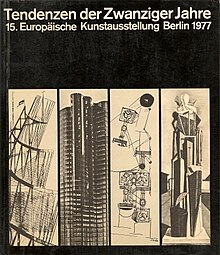Dieter Honisch

Dieter Honisch (born May 11, 1932 in Beuthen ( Upper Silesia ), † December 7, 2004 in Berlin ) was director of the New National Gallery at the State Museums in Berlin from 1975 to 1997 . In 1970 and 1972 he acted as commissioner of the German Pavilion at the Venice Biennale.
life and work
Honisch studied art history in Münster , Vienna and Rome . In 1960 he received his doctorate with a thesis on Anton Raphael Mengs (1728–1779). He first worked for the Westphalian Art Association , where he deepened the exchange with Josef Albers and encouraged him to do his first screen print in 1961. a. 1964 showed in solo exhibitions Ossip Zadkine and Ernst Wilhelm Nay . From 1965 to 1968 he worked for the Württembergischer Kunstverein , where he a. a. From February 18 to March 26, 1967, the exhibition Shapes of Color showed, which dealt with a new understanding and contribution of color to the picture.
His next area of work was the Folkwang Museum in Essen . From there he was appointed director of the New National Gallery West Berlin in the Mies-van-der-Rohe building at today's Kulturforum. After reunification, he was director of the reunified National Gallery . He headed this museum until 1997. Shortly after taking office, in 1977 he re-established the “Association of Friends of the National Gallery”.
From August 14 to October 16, 1977 Honisch led under the patronage of Federal President Walter Scheel on behalf of the Government of the Federal Republic of Germany and the Senate of Berlin under the auspices of the Council of Europe in the New National Gallery Berlin, the Academy of Arts and the Great Orangery of the Charlottenburg Palace in Berlin through the 15th European art exhibition Tendencies of the Twenties (catalog). The complex topic required a differentiated presentation. The exhibition was divided into four sections: “From Constructivism to Concrete Art ”, “From the Futuristic to the Functional City - Planning and Building in Europe from 1913-1933”, “ Dada in Europe - Works and Documents”, “The New Reality - Surrealism and New Objectivity ”.
Dieter Honisch died in Berlin in 2004 at the age of 72. His grave is in the Dahlem forest cemetery .
Fonts
- The National Gallery Berlin . Publishing house Aurel Bongers, Recklinghausen 1979
- Review of art history. In: Wolf Vostell : The Naked and the Dead . Edition Ars Viva / Edition Wewerka, Berlin 1983, ISBN 3-924306-11-7 .
- An introduction to his work and creativity. In: Günther Uecker , Deutsche Bank Verlag, Frankfurt 1985.
- The reality of the picture Anselm Kiefer . In: Anselm Kiefer , Nationalgalerie, Berlin 1991.
Web links
- Literature by and about Dieter Honisch in the catalog of the German National Library
Individual evidence
- ^ Westfälischer Kunstverein: History. Westfälischer Kunstverein, 2018, accessed on June 1, 2018 .
- ^ Edition Domberger: Portfolio »Shapes of Color« 1967. Edition Domberger, 2018, accessed on June 1, 2018 .
- ↑ Dieter Honisch / Ursula Prinz u. a .: Trends of the twenties . Reimer, Berlin 1997, ISBN 3-496-01000-2 .
- ^ Hans-Jürgen Mende: Lexicon of Berlin burial places . Pharus-Plan, Berlin 2018, ISBN 978-3-86514-206-1 , p. 582.
| personal data | |
|---|---|
| SURNAME | Honisch, Dieter |
| BRIEF DESCRIPTION | German art historian and museum director |
| DATE OF BIRTH | May 11, 1932 |
| PLACE OF BIRTH | Beuthen ( Upper Silesia ) |
| DATE OF DEATH | December 7, 2004 |
| Place of death | Berlin |
